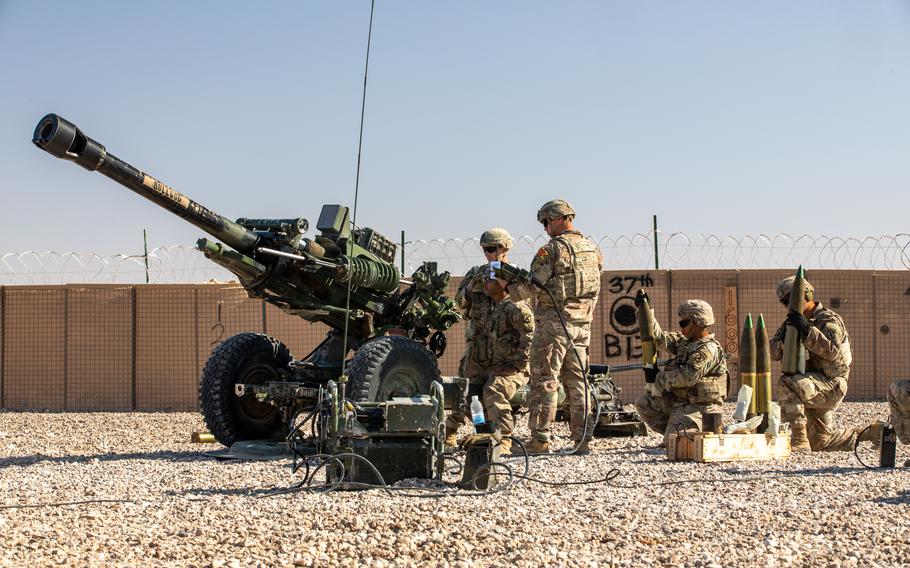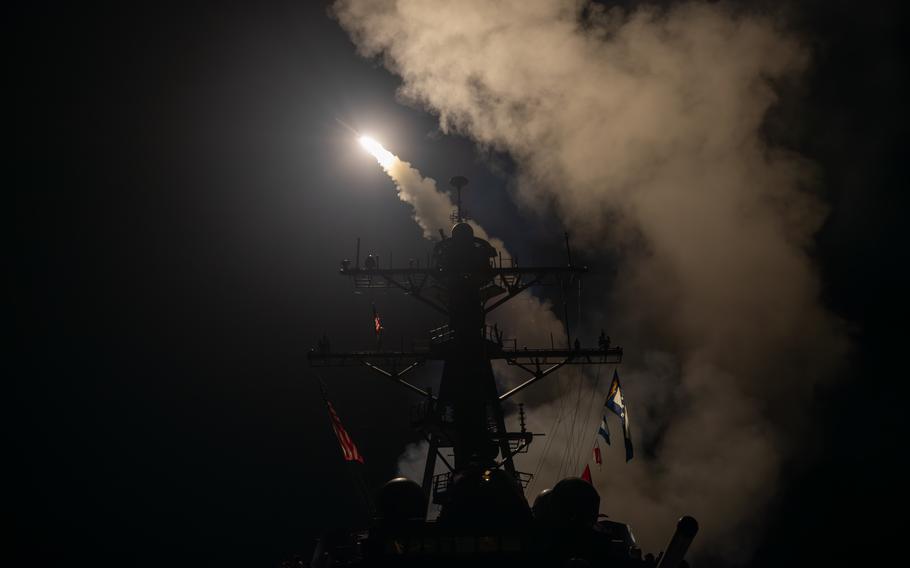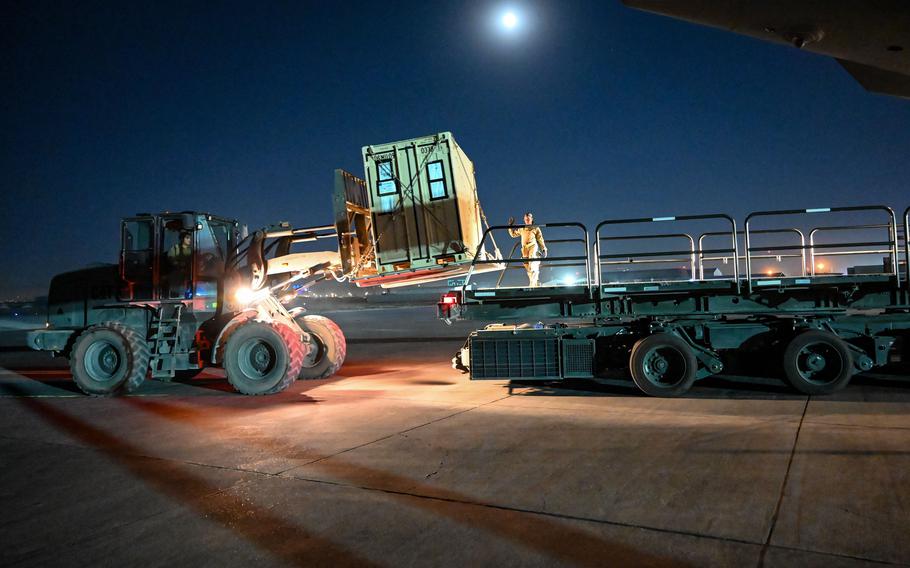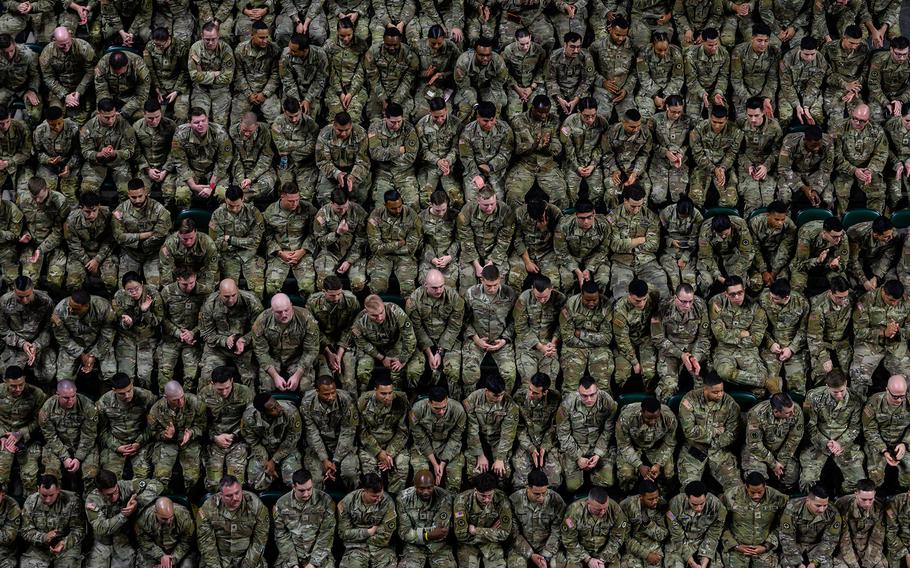
U.S. soldiers from the 10th Mountain Division fire artillery during an exercise at al Asad Air Base in Iraq on Dec. 1, 2023. The base has been a target of attacks by Iranian-backed militants. (Quince Lanford/U.S. Army)
Iranian attacks against three neighboring countries indicate that Tehran has been emboldened by the performance of its militia proteges and raise questions about whether it will directly challenge the U.S. and its partners in the Middle East.
Iran has long preferred to fight a shadow war by funding militant groups, which have intensified their attacks on U.S. troops in the region since the start of the Israel-Hamas war in October.
But missile strikes last week in Syria, Iraq and Pakistan that were claimed by Iran’s powerful Islamic Revolutionary Guard Corps came after its proxies inflicted damage on U.S. military positions at a relatively low cost to Tehran, analysts said.
“I’d say Iran’s leaders have been riding high,” said Jonathan Lord, a senior fellow at the Center for a New American Security.
The direct attacks most likely came from “a feeling of invincibility” as a result of recent successes by proxy groups, which could lead to miscalculation and overreach, Lord said.

The destroyer USS Gravely launches Tomahawk missiles in the Red Sea on Jan. 12, 2024, in response to the repeated attacks on commercial shipping by Iranian-backed Houthi militants in Yemen. (Jonathan Word/U.S. Navy)
Iran’s proxies have repeatedly attacked U.S. troops in Iraq and Syria, including a strike Saturday on al-Asad air base in Iraq that required personnel to be evaluated for traumatic brain injuries. Two cases have been diagnosed so far, U.S. Central Command and Pentagon officials said.
It’s unlikely that Iran would have launched and claimed direct attacks on other countries had the U.S. responded more forcefully against the militant groups targeting U.S. troops in Iraq and Syria, said Alex Plitsas, a senior fellow with the Washington-based Atlantic Council.
“One hundred percent, if they felt that they were going to be held accountable for the actions they’re taking, they wouldn’t be doing what they’re doing,” said Plitsas, an Army veteran. “If you let people get away with things, they’ll try to get away with more.”
Meanwhile, the U.S. says Iran is directly involved in ship attacks by Houthi militants against shipping in the Red Sea, The Associated Press reported Monday.
Vice Adm. Brad Cooper, the head of the Navy’s 5th Fleet, called the attacks on shipping the most significant in two generations.
While the U.S. has blamed Iran for backing these groups financially, there has been little direct action against Tehran for its support, analysts said.
Tehran knows the U.S. has few options to strike back that do not risk starting an open-ended conflict. The White House’s stated goal in the Middle East is to prevent the war between Israel and Hamas from igniting the region.

American airmen from the 443rd Air Expeditionary Squadron offload cargo at Irbil Air Base in Iraq on July 28, 2023. The base was attacked by an Iranian-backed militia in December, and three U.S. service members were wounded. (Breanna Diaz/U.S. Air Force)
Analysts say the U.S. deserves credit for its efforts to stave off warfare in Lebanon, where the heavily armed militant group Hezbollah has mostly remained on the sidelines.
But the U.S.’ consistent signal that it does not want a wider war has given Iran leeway to be more aggressive.
“You cannot just rule out possibility of an escalation and at the same time you hope for achieving deterrence,” said Farzin Nadimi, a senior fellow at the Washington Institute. “The United States probably needs to regain initiative, but that also increases the risks of escalation, obviously.”
At least 83 U.S. troops have been injured in 151 attacks by Iranian-linked militants in Iraq and Syria since October, Maj. Pete Nguyen, a Pentagon spokesman, said Monday.
That tally includes Chief Warrant Officer 4 Garrett Illerbrunn, who was severely wounded in a Christmas Day drone and missile attack at his base in Irbil in northern Iraq.
Illerbrunn was evacuated to Germany and later transferred to Walter Reed National Military Medical Center in Maryland.
But the death of a U.S. service member in a proxy attack would increase pressure on the White House to respond more forcefully against Tehran.
“Because red lines are blurry in the Middle East right now, miscalculation would be easy and could also trigger a wider war,” said Jennifer Kavanagh, senior fellow in the American Statecraft Program at the Carnegie Endowment for International Peace. “Only a diplomatic and political approach is likely to finally contain and de-escalate the conflicts.”

New Jersey National Guard soldiers sit during a farewell ceremony in Trenton, N.J., Jan. 14, 2024. More than 1,500 of the soldiers are deploying to support U.S. Central Command operations in Iraq and Syria. Bases used by U.S. forces in the Middle East have been targets of attacks by Iranian-backed militias. (Michael Schwenk/U.S. Army National Guard)